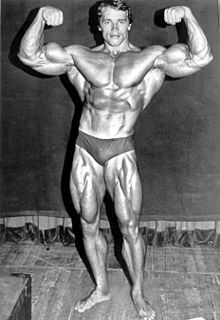
Bodybuilding is the use of progressive resistance exercise to control and develop one's muscles by muscle hypertrophy for aesthetic purposes. It is distinct from similar activities such as powerlifting because it focuses on physical appearance instead of strength. An individual who engages in this activity is referred to as a bodybuilder. In professional bodybuilding, competitors appear in lineups and perform specified poses for a panel of judges who rank them based on symmetry, muscularity, size, conditioning, posing, and stage presentation. Bodybuilders prepare for competitions through the elimination of nonessential body fat, enhanced at the last stage by a combination of extracellular dehydration and carbo-loading, to achieve maximum muscular definition and vascularity; they also tan and shave to accentuate the contrast of their skin under the spotlights.

Weight training is a common type of strength training for developing the strength and size of skeletal muscles. It uses the force of gravity in the form of weighted bars, dumbbells or weight stacks in order to oppose the force generated by muscle through concentric or eccentric contraction. Weight training uses a variety of specialized equipment to target specific muscle groups and types of movement.

Powerlifting is a strength sport that consists of three attempts at maximal weight on three lifts: squat, bench press, and deadlift. As in the sport of Olympic weightlifting, it involves the athlete attempting a maximal weight single-lift effort of a barbell loaded with weight plates. Powerlifting evolved from a sport known as "odd lifts", which followed the same three-attempt format but used a wider variety of events, akin to strongman competition. Eventually odd lifts became standardized to the current three.

A barbell is a piece of exercise equipment used in weight training, bodybuilding, weightlifting, powerlifting and strongman, consisting of a long bar, usually with weights attached at each end.
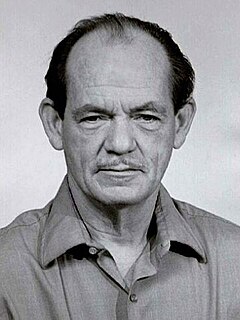
Arthur Allen Jones was the founder of Nautilus, Inc. and MedX, Inc. and the inventor of the Nautilus exercise machines, including the Nautilus pullover, which was first sold in 1970. Jones was a pioneer in the field of physical exercise i.e. weight and strength training. He was born in Arkansas, and grew up in Seminole, Oklahoma.
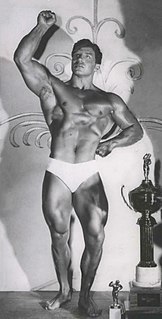
William Arnold Pearl is an American retired professional bodybuilder and athlete. During the 1950s and 60s, he won many titles and awards, including winning the Mr. Universe contest five times, and was named "World's Best-Built Man of the Century." He later became an expert trainer and author on bodybuilding.
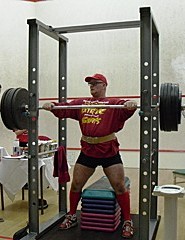
A power rack is a piece of weight training equipment that functions as a mechanical spotter for free weight barbell exercises without the movement restrictions imposed by equipment such as the Smith machine. Its general design is four upright posts with two adjustable horizontal bar catches on each side. Many power racks also have accessory attachments, such as a chin-up bar, pulldown cable attachment, or pegs for storing weight plates.
Dinosaur training is a philosophy of weight training / physical culture promoting a return to traditional strongman types of exercises and training.
Peary Rader was an American early bodybuilder, Olympic lifter, writer, and magazine publisher from Nebraska. He was the founding publisher of Iron Man from 1936 to 1986.

The following outline is provided as an overview of and topical guide to exercise:
Dona Oliveira was a professional female bodybuilder from the United States. She competed from the mid-1980s through the early 1990s.
Robert Kennedy was the founder of Robert Kennedy Publishing, based in Mississauga, Ontario.
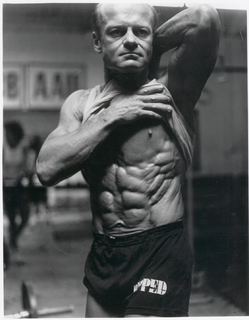
Clarence Bass is an American writer, fitness expert, and retired lawyer. He is best known for his book and DVD series Ripped, which chronicle his fitness, including becoming a past-40 bodybuilding champion. Bass was a writer for Muscle & Fitness where he had a question and answer column. He has continued to write, documenting his fitness over a span of approximately 60 years in various books that he has released since 1980. He is featured in the books Second Wind and Legends of the Iron Game. In the June 2017 issue of Men's Health, Bass was named "one of America’s greatest fitness visionaries."

Todd 'The Bod' Smith is an American body builder, personal trainer, health and exercise writer, and businessman.

Harry "Hang-Ten" George Haureliuk was an Australian professional Bodybuilding champion competing under the International Natural Bodybuilding Association (INBA). In 2008, Harry was the first Australian recipient to be inducted into the International Bodybuilding Hall of Fame, no other INBA athlete has competed at such a high level.

Roy Stanley Hilligenn was an American bodybuilder who was awarded the title of Mr. South Africa for four years, as well as AAU Mr. America in 1951. Famous for his strength, vegetarianism, and smile, Hilligenn mixed bodybuilding and weight training in his fitness programs. He appeared on famous magazine covers such as Strength & Health and Iron Man during his bodybuilding career. Standing at only 5'6"(167.64cm), Hilligenn was the shortest person to ever win the Mr. America title.

Fitness culture is a sociocultural phenomenon surrounding exercise and physical fitness. It is usually associated with gym culture, as doing physical exercises in locations such as gyms, wellness centres and health clubs is a popular activity. An international survey found that more than 27% of world total adult population attends fitness centres, and that 61% of regular exercisers are currently doing "gym-type" activities. Getting and maintaining physical fitness has been shown to benefit individuals' inner and outer health. Fitness culture has become highly promoted through modern technology and from the rising popularity of social media platforms.

Siegmund Klein was a German-American strongman, bodybuilder, magazine publisher, and gymnasium owner prominent in physical culture. He was inducted into the IFBB Hall of Fame in 2006.
Repetition (repeat) — re-performing a specific movement exercises with the burden in one approach (set) in bodybuilding, powerlifting, weightlifting and some other strength sports. The repetition of the exercises is a kind of methods and principles of strength training, which are resorted to by athletes with a long experience of training for the new "shock" of muscles, contributing to the release of "stagnation", the continuation of muscle growth, as well as recovery from overtraining, or, conversely, consciously bringing yourself to a state close to overtraining, for example, before performances, when you need a gradual increase in the intensity of training and muscle to strength fixation and / or “drying” for performance in competitions — lifting extra-large weights or demonstrating muscle relief.














